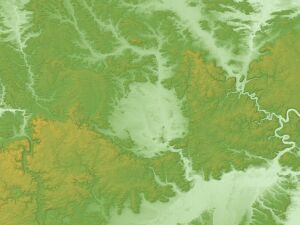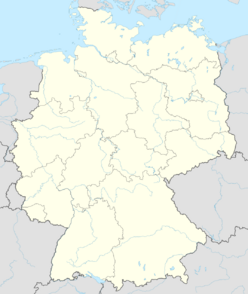Earth:Nördlinger Ries
 Relief map of Nördlinger Ries | |
| Impact crater/structure | |
|---|---|
| Confidence | Confirmed |
| Diameter | 24 km (15 mi) |
| Age | 14.808 ± 0.038 Ma, Middle Miocene |
| Exposed | Yes |
| Drilled | Yes |
| Bolide type | Achondrite |
| Location | |
| Coordinates | [ ⚑ ] : 48°53′N 10°34′E / 48.883°N 10.567°E |
| Country | Germany |
| State | Bavaria and Baden-Württemberg |
| District | Donau-Ries |
| Municipality | Nördlingen |
The Nördlinger Ries is an impact crater[1] and large circular depression in western Bavaria and eastern Baden-Württemberg. It is located north of the Danube in the district of Donau-Ries. The city of Nördlingen is located within the depression, about 6 kilometres (3.7 mi) south-west of its centre.
Etymology
"Ries" is derived from Raetia, since the tribe of Raetians lived in the area in pre-Roman times.[2][3]
Description
The depression is a meteorite impact crater formed 14.808 ± 0.038 million years ago in the Miocene.[4][5] The crater is most commonly referred to simply as Ries crater or the Ries. The original crater rim had an estimated diameter of 24 km (15 mi). The present floor of the depression is about 100 to 150 m (330 to 490 ft) below the eroded remains of the rim.
It was originally assumed that the Ries was of volcanic origin. In 1960 Eugene Shoemaker and Edward C. T. Chao showed that the depression was caused by meteorite impact.[6] The key evidence was the presence of coesite, which, in unmetamorphosed rocks, can only be formed by the shock pressures associated with meteorite impact. The coesite was found in suevite from Otting quarry,[7][6] but even before, Shoemaker was encouraged by St. George's Church in Nördlingen, which is built of locally derived suevite.[7] The suevite was formed from mesozoic sediments shocked by the bolide impact.[8][9][10]
The Ries impact crater was a rampart crater, thus far a unique finding on Earth.[11] Rampart craters have almost exclusively been found on Mars. Rampart craters exhibit a fluidized ejecta flow after impact of the meteorite, most simply compared to a bullet fired into mud, with the ejecta resembling a mudflow.
Another impact crater, the much smaller (3.8 km (2.4 mi) diameter) Steinheim crater,[12] is located about 42 km (26 mi) west-southwest from the center of Ries. It had previously been thought that the two craters formed simultaneously by the impact of a binary asteroid 14.8 million years ago, but a study published in 2020 suggests that Steinheim could actually be about 500,000 years younger than Nördlinger Ries.[13]
Recent computer modeling of the impact event indicates that the impactors probably had diameters of about 1.5 km (4,900 ft) (Ries) and 150 m (490 ft) (Steinheim), had a pre-impact separation of some tens of kilometers, and impacted the target area at an angle around 30 to 50 degrees from the surface in a west-southwest to east-northeast direction. The impact velocity is thought to have been about 20 km/s (72,000 km/h; 45,000 mph). The resulting explosion had the power of 1.8 million Hiroshima bombs, an energy of roughly 2.4×1021 joules.
The Ries crater impact event is believed to be the source of moldavite tektites found in southern Bohemia and Moravia (Czech Republic).[14] The tektite melt originated from a sand-rich surface layer that was ejected to distances up to 450 km (280 mi) downrange of the crater. The shape of the strewnfield suggests that the direction of impact was from the west-southwest.[15]
Stone buildings in Nördlingen contain millions of tiny diamonds, all less than 0.2 mm (0.008 in) across. The impact that caused the Nördlinger Ries crater created an estimated 72,000 tonnes (72,000,000 kg) of them when it impacted a local graphite deposit. Stone from this area was quarried and used to build the local buildings.[16]
Archaeology
On one edge of the Nördlinger Ries are the Ofnet Caves, where, at the beginning of the 20th century, archaeologists discovered thirty-three human skulls dating to the Mesolithic period.[17]
Astronaut training
The landing site for Apollo 14 is a heavily craterized terrain, and one of the science goals of the mission was to sample ejecta from the impact that formed Mare Imbrium. Nördlinger Ries is an easily accessible, large impact crater, making it a convenient analog for lunar craters. Because of this, it was used as a location to train Apollo 14 astronauts, so that they would be able to investigate lunar impact structures and related rocks.[18] Astronauts Alan Shepard and Edgar Mitchell, as well as Apollo 14 backup astronauts Eugene Cernan and Joe Engle, trained here from August 10 to August 14, 1970.[19]
References
- ↑ J. Baier: Geohistorische Bemerkungen zur Suevit-Forschung (Ries-Impakt). Geohistorische Blätter, 31(1/2), Berlin 2020.
- ↑ "37 Ries". Entwurf einer kulturlandschaftlichen Gliederung Bayerns als Beitrag zur Biodiversität. Bayerisches Landesamt für Umwelt. 2011. https://www.lfu.bayern.de/natur/kulturlandschaft/entwurf_gliederung/doc/37_ries.pdf.
- ↑ Schmidt F. G. G. (1896). "The Dialect of the Ries". Modern Language Notes 11 (5): 142–144. doi:10.2307/2918785.
- ↑ Schmieder M., Kennedy T., Jourdan F., Buchner E., Reimold W. U. (2018). "A high-precision 40Ar/39Ar age for the Nördlinger Ries impact crater, Germany, and implications for the accurate dating of terrestrial impact events". Geochimica et Cosmochimica Acta 220: 146–157. doi:10.1016/j.gca.2017.09.036. Bibcode: 2018GeCoA.220..146S.
- ↑ Schwarz, Winfried H.; Hanel, Michael; Trieloff, Mario (February 2020). "U‐Pb dating of zircons from an impact melt of the Nördlinger Ries crater" (in en). Meteoritics & Planetary Science 55 (2): 312–325. doi:10.1111/maps.13437. ISSN 1086-9379. Bibcode: 2020M&PS...55..312S.
- ↑ Jump up to: 6.0 6.1 Shoemaker, EM; Chao, ECT (1961). "New Evidence for the Impact Origin of the Ries Basin, Bavaria, Germany". J. Geophys. Res. 66 (10): 3371–3378. doi:10.1029/JZ066i010p03371. Bibcode: 1961JGR....66.3371S.
- ↑ Jump up to: 7.0 7.1 Cokinos C. (2009). The Fallen Sky. Penguin. ISBN 9781101133224. https://books.google.com/books?id=1uFRVyFxA04C&q=coesite&pg=PT246.
- ↑ Baier, Johannes (2007). "Die Auswurfprodukte des Ries-Impakts, Deutschland". Documenta Naturae (München) 162. ISBN 978-3-86544-162-1.
- ↑ Baier, Johannes (2008). "Zur Herkunft der Suevit-Grundmasse des Ries-Impakt Kraters". Documenta Naturae (Munich) 172. ISBN 978-3-86544-172-0.
- ↑ Baier, Johannes (2012). "Die Bedeutung von Wasser während der Suevit-Bildung (Ries-Impakt, Deutschland". Jber. Mitt. Oberrhein. Geol. Ver. 94: 55–69. http://www.schweizerbart.de/papers/jber_oberrh/detail/94/76905/Die_Bedeutung_von_Wasser_whrend_der_Suevit_Bildung.
- ↑ Sturm, Sebastian; Wulf, Gerwin; Jung, Dietmar; Kenkmann, Thomas (2013). "The Ries impact, a double-layer rampart crater on Earth". Geology 41 (5): 531–534. doi:10.1130/G33934.1. Bibcode: 2013Geo....41..531S.
- ↑ Baier, Johannes; Scherzinger, Armin (2010). "Der neue Geologische Lehrpfad im Steinheimer Impakt-Krater". Jber. Mitt. Oberrhein. Geol. Ver 92: 9–24. http://www.schweizerbart.de/papers/jber_oberrh/detail/92/76658/Der_neue_Geologische_Lehrpfad_im_Steinheimer_Impak.
- ↑ Buchner, E.; Sach, VJ; Schmieder, M (2020). "New discovery of two seismite horizons challenges the Ries–Steinheim double-impact theory". Sci Rep 10 (1): 22143. doi:10.1038/s41598-020-79032-4. PMID 33335157. Bibcode: 2020NatSR..1022143B.
- ↑ Graup, Günther; Horn, Peter; Köhler, Horst; Müller-Sohnius, Dieter (1981). "Source material for moldavites and bentonites". Naturwissenschaften (Berlin) 67 (12): 616. doi:10.1007/BF00398615. Bibcode: 1981NW.....68..616G.
- ↑ Holm-Alwmark, Sanna; Alwmark, Carl; Ferrière, Ludovic; Meier, Matthias M. M.; Lindström, Sofie; Kenny, Gavin G.; Sheldon, Emma; Schweigert, Günter et al. (2021-04-02). "Shocked quartz in distal ejecta from the Ries impact event (Germany) found at ~ 180 km distance, near Bernhardzell, eastern Switzerland" (in en). Scientific Reports 11 (1): 7438. doi:10.1038/s41598-021-86685-2. ISSN 2045-2322. PMID 33811229. Bibcode: 2021NatSR..11.7438H.
- ↑ Emsley, John (2001). Nature's Building Blocks. Oxford University Press. p. 99. ISBN 0-19-850341-5.
- ↑ Onians, R. B. (1988). The Origins of European Thought. Cambridge University Press. p. 541. ISBN 978-0521347945. https://archive.org/details/originseuropeant00onia.
- ↑ Pondrelli, Monica; Baker; Hauber (2018). "Geologic Tools". Planetary Geology. Springer. pp. 15–31. doi:10.1007/978-3-319-65179-8_2. ISBN 978-3-319-65177-4. https://doi.org/10.1007/978-3-319-65179-8_2.
- ↑ Phinney, William (2015). Science Training History of the Apollo Astronauts. NASA SP -2015-626. pp. 237.
External links
| Wikimedia Commons has media related to Nördlinger Ries. |
- Ries at Earth Impact Database
- Travel for Kids: Nordlingen, Germany
- Information on meteorite and aerial photo of town, scroll two thirds of the way down page
 |






